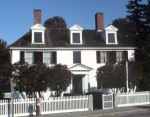
Sunny Valley, Ore.
Rootworks
2000 King Mountain Trail
Southern Oregon has a rich history of lesbian and gay back-to-the-land projects. One lesbian separatist community, Rootworks, was established in the 1970s by Ruth and Jean Mountaingrove, when both women were in their 50s. “The philosophy was that we would live without men, separate from the patriarchal world,” Ruth told me in the late ’90s. “That is still pretty much the idea.” (The photo above was taken by Ruth at the commune in the 1970s.)
At Rootworks, there were originally only two houses – the Moonhouse and the Kitchen cabin. In the years that followed the founding, Ruth and Jean added the Sunhouse, a barn (called “Natalie Barney”), and the All Purpose crafts cabin. In the barn is a study and a feminist library. From 1974 to 1984, Ruth and Jean also published the magazine WomanSpirit from an office in the barn, and The Blatant Image, a feminist magazine about photography, was published there from 1981 to 1983; back issues of both are stored in the barn.
Ruth has credited WomanSpirit with bringing a lot of women to the southern Oregon region, by encouraging their creativity and spirituality. Though the magazine folded, Jean said, “the main elements of WomanSpirit are still being lived in the community – feminism, spirituality, all forms of creativity, sisterhood, nature, art, music, dance, literature, healing and personal development.”
Gardens that are nestled around some of the Rootworks buildings are filled with vegetables, beans, and berries. Solar energy provides heat and hot water and also powers the community’s lights. Ruth noted that it’s “not easy in the winter, and that’s when women usually leave.”
In 2008, Linda Long, Manuscripts Librarian for the Special Collections and University Archives at the University of Oregon in Eugene, told Lambda Book Report:
Rootworks is a historical site that is a perfect exemplar of the feminist-lesbian dream. From the 1970s to today, the women’s back-to-the-land community in Oregon was, and is, a dynamic expression of the separatist dream. As part of that dream, women experimented with new ways to live and work together – and with all sorts of activities and rituals, from house-building projects and collective gardening to the sacred circle. Many of the women were aspiring artists of one kind or another – writers, painters, photographers—and they hoped to be able to combine life on the land with their creative work. All of this lesbian/feminist life and work is represented in Rootworks…The permanence of Rootworks and its status as a women-owned land trust in perpetuity makes it a perfect example of a historic site. I think a living museum would be an effective and dynamic way to preserve the lesbian land dream and the history of the lesbian community in Southern Oregon.”






You must be logged in to post a comment.